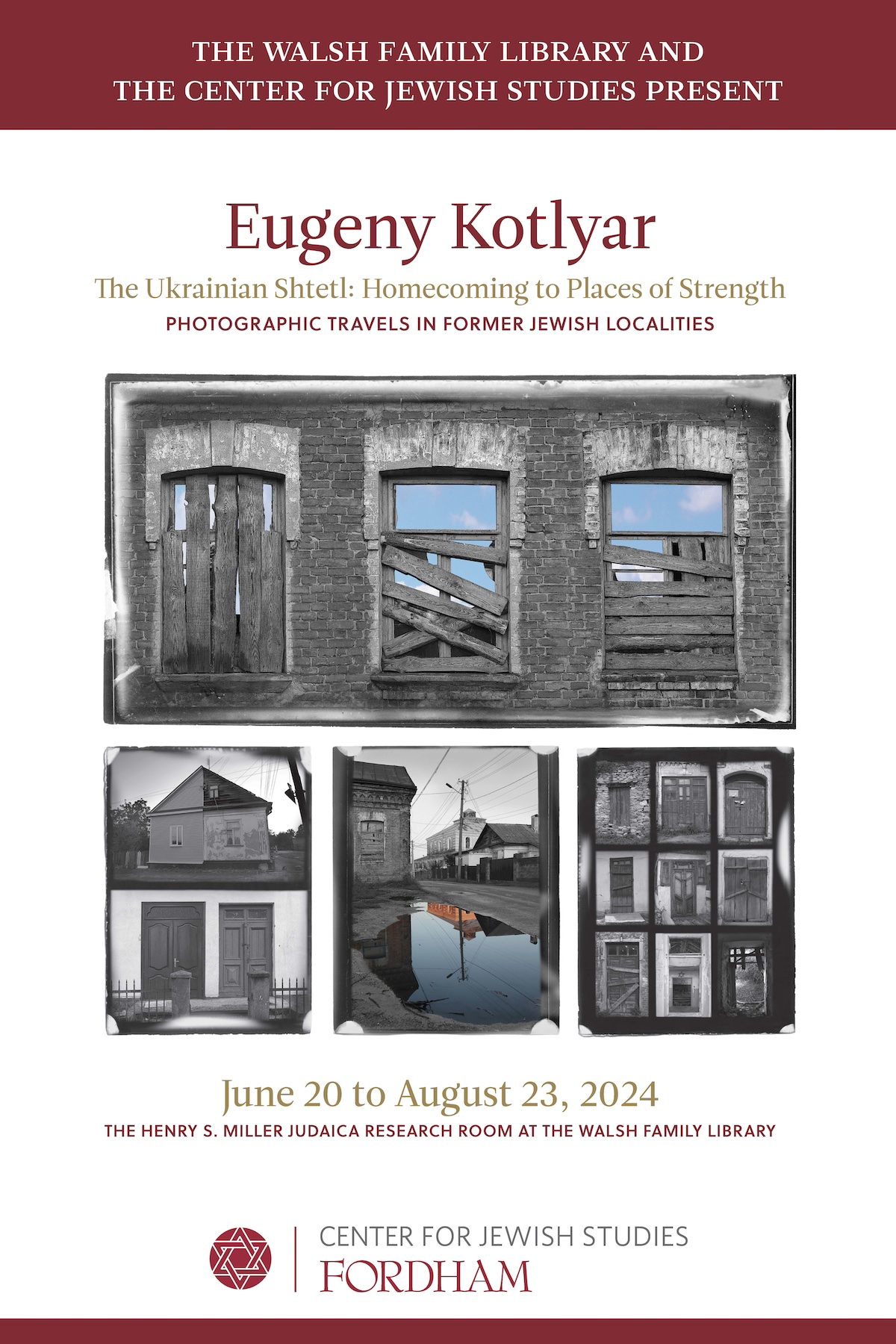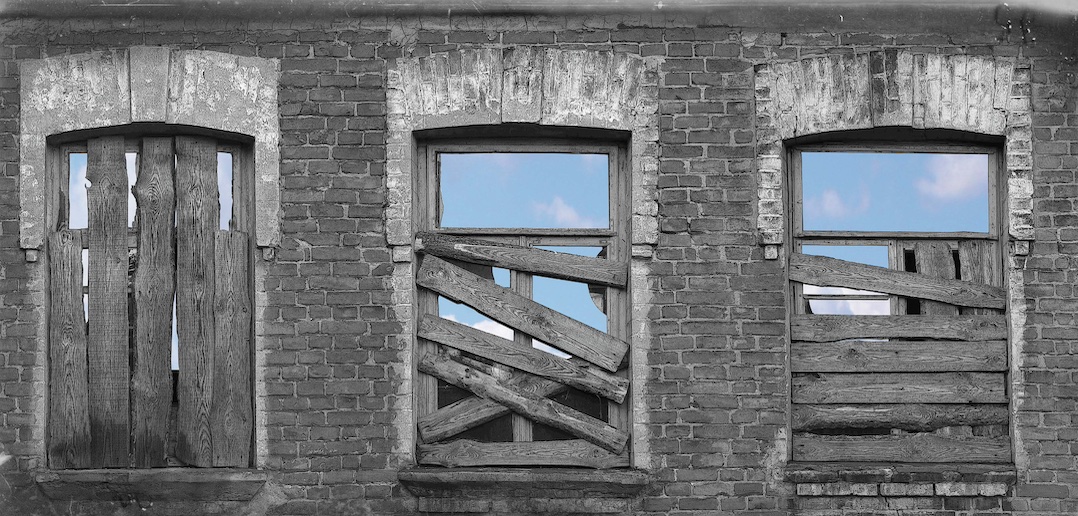A Foreword by Magda Teter
Since the fall of 2022, the Henry S. Miller Judaica Research Room has served as a space for exhibits related to contemporary Jewish art and experience. During the summer of 2024, we are showing the photographs of Eugeny Kotlyar, a scholar and artist from Kharkiv. In the fall of 2023, an exhibit of Kotlyar’s gorgeous stained glass designs for restituted synagogues in Ukraine, “The Light of the Revival,” showcased the revival of Jewish culture and re-discovery of Jewish heritage in post-independence Ukraine.

The exhibit on view this summer–“The Ukrainian Shtetl: Homecoming to Places of Strength—Photographic Travels by Eugeny Kotlyar”–features black and white photographs and photographic montages of small towns that used to be the beating heart of east European Jewish life and culture and also sites of its destruction. Now–even without the impact of the current war–desolate and seemingly forgotten, these towns seem covered with an aura of nostalgia and serenity. But Kotlyar breaks that aura of nostalgia and serenity with subtle pointers: the elderly minyan shows a group of elderly Jewish men, faint remainders of the once thriving towns; and two portraits of a local man and a woman are titled “Keepers of secrets.”
In contemporary eastern Europe–Ukraine, Poland, Belarus, Lithuania, and other places–cemeteries and abandoned synagogues are the entry point to Jewish life, a poignant echo of the fact that a Jewish cemetery is sometimes called in Hebrew beit hayim (a house of life). Kotlyar’s exhibit captures that exquisitely. The remnants of Jewish cemeteries are both a reminder of the vibrant past and of the loss in death, abandonment, and destruction. Kotlyar’s photos succeed in capturing both aspects of Ukraine’s Jewish past. Because the lands of what is now modern Ukraine were a birthplace of Hasidism and the home of Hasidic dynasties, some Jewish cemeteries, in towns where famous zaddikim lived have not only attracted pilgrims but also new religious and communal revival. Kotlya’s collage of photos of a landscape, a memorial, an archival photo of a Jewish couple from the early twentieth century, and Kotlyar himself with his son subtly brings to life the past and the present, the memory of that past and the lived present.
Artist Statement: THE UKRAINIAN SHTETL. HOMECOMING TO PLACES OF STRENGTH: Photographic travels in former Jewish localities
By Eugeny Kotlyar
The memory of the traditional world of Jewish small towns in eastern Europe has been slowly disappearing since the beginning of the last century. The shtetl, a small town, is both a real and imagined place in Jewish history and memory. The world of the shtetl lasted for more than five centuries. It belonged to many eastern European countries, as the region’s political boundaries shifted from the Polish-Lithuanian Commonwealth to the Russian Empire and its Pale of Jewish Settlement. This world experienced the hardest shocks of wars, pogroms, evictions of Jews, and socio-political and economic upheavals and always tried to adapt to the new life. But its life was cut short first by World War I and the October Revolution, and then, ultimately, by the Holocaust.

After the loss of life, the stones began to disappear, the streets and traces of the past were increasingly erased, and the memory started to fade away. The former shtetl acquired different metaphysical meanings through which everyone has been finding their own source of life and strength and their own light. Vanishing and unquenchable. A light that only black and white film could truly convey. This desolation, however, is not a dumping ground for old things. It is a world still full of human warmth and deep mystical power.

In the 21st century, this world has also become my place of power. From my native Kharkiv in the east of the country, fate led me on unpredictable paths to western Ukraine. I first came here as a traveler more than 20 years ago. Later I brought my relatives, friends, and students to these places and organized scholarly expeditions and plenaries. Then, in March 2022, my family and I fled here, seeking refuge from Russian shelling. A year ago, these old sites brought me to their fully-developed living space, filled with holiness, prayer, and modern community life. It was already a new experience of pilgrimage to the realm of graves and the spirit of the great Hasidic tzaddikim.

Over the years I used a film camera, then a digital, and finally a high-quality smartphone camera. I shot greedily, afraid of missing out on anything of value. The feeling that I would be the last to capture the still-vanishing world of the shtetl became obsessive. The allure of old photographs mentally brought me back to this black-and-white world, and I clung to this style to free myself from modernity. Documentary stylization became my preference. I tried to enrich the image of the recorded subject, to poeticize it, using montages, softness or contrast, darkening of the frame and frames that refer to prints from old glass photographic plates.
For two decades, I have been tracking the changing life of the Ukrainian province. Away from the bustling civilization, time flowed differently here, slowing down and stopping. With each new trip, I rediscovered familiar places, looked for changes, and listened to the exciting silence. My thoughts took me deep into the eras when the classic shtetl breathed its full breath, and when its breath was interrupted. But even in this space of the boundless power of the winds, I continue to feel the current of life and the lightness of my own breath.
I suddenly realized that neither I nor the generations to come will be the last witnesses of the shtetl. Slowly and steadily losing its authentic appearance, this space will reveal itself to contemporaries and descendants in a new way. In the age of digitalization, virtualization, and artificial intelligence, the technologies of the future will help us not to forget the past. So, the world of the shtetl will always be accessible to direct or indirect contact. It will always remain a place of deep longing, inexplicable love, and abiding power.
Eugeny Kotlyar, Kyiv, May 4, 2024
This exhibition is made possible thanks to the generosity of a Fordham Trustee Henry S. Miller, Mr. Eugene Shvidler GBA’ 92, members of the CJS advisory board, and anonymous donors to the Center for Jewish Studies at Fordham. The Center for Jewish Studies at Fordham is grateful to Fordham University’s Walsh Family Library and especially the O’Hare Special Collections for their support. We are especially grateful to Linda Loschiavo, the Director of the Walsh Family Library, and Gabriella DiMeglio and Vivian Shen at the O’Hare Special Collection.


